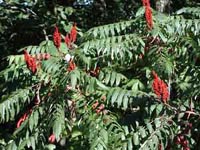Resource Library
Plant of the Week: Sumac, Smooth
The University of Arkansas System Division of Agriculture does not promote, support or recommend plants featured in "Plant of the Week." Please consult your local Extension office for plants suitable for your region.
Plant of the Week
Smooth Sumac
Latin: Rhus glabra

Fall has arrived with its many resplendent glories. The changing pallet of autumnal foliage delights and amazes us each October and, even the most jaded amongst us cannot help but be uplifted by the beauty and the cooler temperatures of the season.
While trees are the poster children for fall, a number of smaller plants add significantly to the display. Of these, smooth sumac (Rhus glabra), is one of the most beautiful but unappreciated plants of the season.
Sumacs get lonely, so you never see them growing alone. Along Interstate 40 between Conway and Fort Smith are half-acre size thickets where the various colonies abut against one another, showing slightly different plant heights, flowering time and fall foliage colors. Each colony represents a clone, all arising from a common rootstock.
Sumacs are pioneer species that established in the rights of way in the 1970s when the Interstate was completed, slowly occupying more ground each season. Spread of these colonies is by means of an underground rhizome that sprawls in every direction as soil conditions and competition permit. In the productive soils of Indiana, colonies spread at a rate of about three feet a year, but in the poorer soils of the Interstate median, the rate of expansion is undoubtedly slower.
The oldest and tallest plants are in the center of the colony, but they seldom exceed 10 feet high. The16-inch long leaves are pinnately compound with the 15 to 25 leaflets arrayed opposite one another down the central rachis.
In the fall, these leaves turn to shades of orange and red, but along the way they show many intermediate shades. Individual leaflets make their own decision about the transition from summer to fall, so patches of green admix with the autumnal colors in a crazy quilt pattern.
The historian Francis Parkman wrote in The Oregon Trail of his 1846 adventures traveling with a band of Siouxas they hunted buffalo with bow and arrow on the plains of present day Wyoming. The peace pipes he shared with the chiefs of the tribe were a blend of sumac and tobacco, with sumac the principle ingredient.
Sumacs are dioecious, meaning that individual colonies will be either male or female. Flowers appear at the end of the branches in early summer as 6-inch tall, yellow-green, ice cream cone shaped panicles. Female plants then produce the familiar head of maroon berries in the fall. These berries, while hardly fleshy, can be harvested and used to make a reasonably tasty pink lemonade-like tea.
One reference suggests using an old washing machine agitator to beat the berries around for half an hour or so to extract the vitamin C and flavor. Strain the resultant mash through a bit of cheesecloth; add sugar and you are ready to drink.
This is one of the most common plants in the United States, appearing in every one of the lower 48 states, and in almost every county of the eastern states. But, on the whole, Americans tend to be indifferent to our native plants so sumac is almost never seen in a planted landscape. Occasionally, the laceleafed staghorn sumac (R. typhina 'Laciniata') will be grown, but almost never will we see colonies of the others spreading across the landscape.
Should you wish to try, the plant is easily transplanted from an existing clump by digging up a bit of the rhizome. Don't bother trying to move any of the top; just move the roots. The first couple years you won't have much to show for your efforts, but in a few years the colony will start to expand.
They are important wildlife food with young shoots relished by deer and the seeds eaten by turkey, quail and a number of songbirds. Sumac is intolerant of shade, but otherwise is not the least bit demanding.
By: Gerald Klingaman, retired
Extension Horticulturist - Ornamentals
Extension News - October 10, 2003
The University of Arkansas System Division of Agriculture does not maintain lists of retail outlets where these plants can be purchased. Please check your local nursery or other retail outlets to ask about the availability of these plants for your growing area.